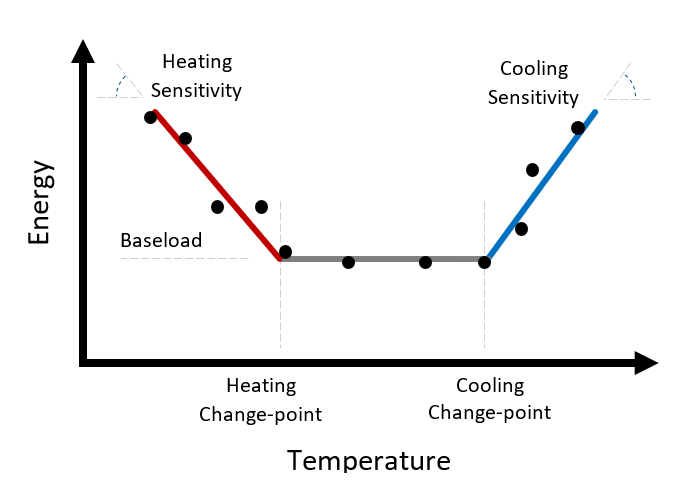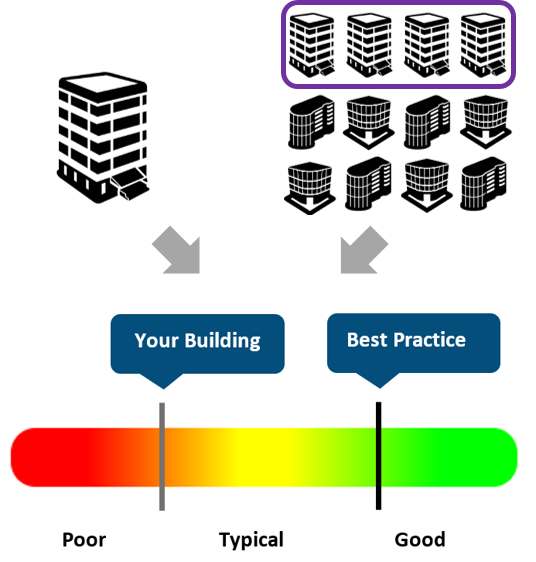Energy and Weather Patterns
BETTER uses regression techniques to analyze a building's monthly energy use in response to weather conditions in order to determine how much energy is weather-sensitive (heating and cooling), and weather-independent (lighting, plug loads, etc.). Normalized energy use data is fit to temperature patterns to determine whether heating and cooling set points are appropriate and whether equipment is performing for optimal energy efficiency.

Change-point Models
Baseload
Energy consumption of all non-weather-related equipment like computers and lighting. The lower the baseload, the less the energy consumed in plugs and permanently plugged equipment.
Cooling sensitivity
Cooling system energy consumption for each degree increase in outdoor temperature. Low cooling sensitivity results in less energy-consuming cooling system.
Cooling change-point
The temperature at which the building's energy consumption begins to increase as the temperature increases.
Heating sensitivity
Heating system consumption of energy for each degree decrease in outdoor temperature. Low heating sensitivity results in less energy-consuming heating system.
Heating change-point
The temperature at which the building's energy consumption begins to increase as the temperature decreases.
Benchmarking
The energy performance of a building analyzed by BETTER is compared to similar buildings. Users can choose to benchmark their buildings either against their own portfolio or against a default benchmark data set provided by BETTER. In addition to telling users whether a building's energy consumption is higher or lower than its peers, BETTER goes a step further by telling users why that is the case. If a building's energy use is high compared to peers, for example, it may be because the heating system is performing poorly, while the cooling system and baseload equipment may be typical compared to peers.
With this information, a building operator can adjust heating setpoints, add insulation, or perform an energy audit that focuses on heating equipment. The process of benchmarking allows users to see how their buildings compare to others, which allows them to make the best strategic decisions to increase energy efficiency and cost savings across their portfolio.

Energy Efficiency Recommendations
BETTER provides energy efficiency recommendations tailored to each building and portfolio. A building or portfolio in which the heating system is performing poorly, for example, will receive recommendations targeting that particular issue. Recommendations range from no-cost operational adjustments to major retrofits. Click here to see how the change-point model coefficients in BETTER map to specific energy efficiency recommendations. For each energy efficiency recommendation, BETTER provides implementation guidance and links to dozens of resources from the U.S. Department of Energy, U.S. Environmental Protection Agency (EPA), and national laboratories that help building operators take immediate action to reduce energy consumption, costs, and greenhouse gas (GHG) emissions.
Energy and Cost Savings Potentials
BETTER analyzes the building’s performance to determine potential energy, cost, and greenhouse gas (GHG) emissions reductions. Worse-performing buildings will have greater savings opportunities than buildings that are already performing well. Graphs showing potential cost savings as well as expected energy consumption reductions are provided in BETTER’s output reports.
Publications
Szum, C., Li, H., Mitchell, R., Applegate, S., Engelman, B., Long, N., Roussev, Y., Noller, E. (2024) New U.S. Data Tools are Playing a Crucial Role in Decarbonizing Buildings at Speed, Scale, and Low Cost. 2024 ACEEE Summer Study on Energy Efficiency in Buildings
Ding, C., Szum, S., Li, H., Zhou, N., Nesler, C. (2021) Data-Driven Analysis Tool Plays Critical Role in Climate Neutral Buildings. Advances in Applied Energy
Li, H., C. Szum, S. Snyder, S. Lisauskas, and A. Bekhit. (2019, January). Targeting Building Energy Efficiency Opportunities - An Open-source Analytical and Benchmarking Tool. In Proceedings of the 2019 ASHRAE Winter Conference. Atlanta, GA: ASHRAE.
Donnelly, M. J Kummer, K. Drees. (2013). LEAN Energy Analysis: Using Regression Analysis to Assess Building Energy Performance. Johnson Controls Institute for Building Efficiency.
Case Studies
- Portfolio Case Study: BETTER Enables California State Agency to Cut Energy Spend by an Estimated $834,000 Annually .
- Building Case Study: BETTER Helps California State Agency Building Cut Energy Spend by an Estimated $100,000 Annually
- Nonprofit Case Study: BETTER Enables PowerOptions To Find $2.5 Million in Potential Annual Energy Cost Savings for Its Nonprofit Members
Trainings
-
BETTER Introducción y Formación Básica
May 16, 2025
- Presenter: Lawrence Berkeley National Laboratory
- Language: Spanish
-
Introduction to BETTER and Training for New Users
May 16, 2025
- Presenter: Lawrence Berkeley National Laboratory
- Language: English
-
Implementando “Ganancias Rápidas” para el Rendimiento Energético de las Edificaciones
July 30, 2020
- Presenter: Lawrence Berkeley National Laboratory
- Language: Spanish
-
Using BETTER to Implement a “Quick Wins” Building Energy Performance Improvement Strategy
July 16, 2020
- Presenter: Lawrence Berkeley National Laboratory
- Language: English
-
Introduction to the Building Efficiency Targeting Tool for Energy Retrofits (BETTER)
July 15, 2020
- Presenter: Lawrence Berkeley National Laboratory
- Language: English
-
Recolectando y Preparando Datos para Mejorar el Rendimiento Energético de las
Edificaciones a través de la herramienta BETTER
June 24, 2020
- Presenter: Lawrence Berkeley National Laboratory
- Language: Spanish
-
Collecting and Preparing Data to Use BETTER to Improve Building Energy Performance
May 14, 2020
- Presenter: Lawrence Berkeley National Laboratory
- Language: English
Visit our News page to learn about upcoming trainings!